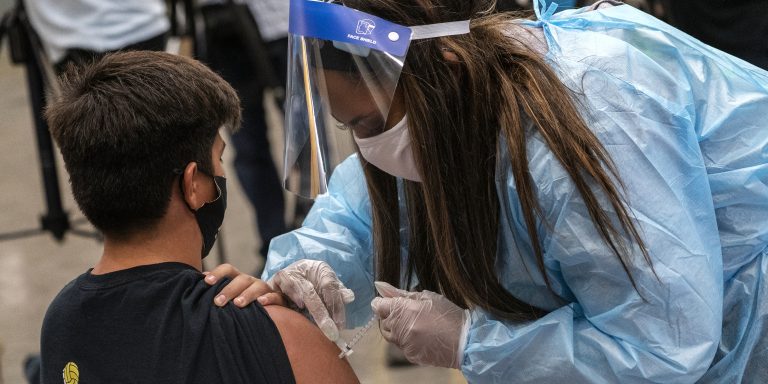INTELBRIEF
September 27, 2021
IntelBrief: The Damage of Police Hesitancy Over Vaccination

Bottom Line Up Front
- In 2020, COVID-19 was the leading cause of death in law enforcement in the U.S.
- The ongoing pandemic will likely be the leading cause of law enforcement deaths once again in 2021.
- There have been numerous high-profile cases of police departments opposing vaccinations, the same way some departments did with masks.
- There are few more tangible ways to “protect and serve” than police getting vaccinated and decreasing the chances of spreading the virus in the community.
The ongoing COVID-19 pandemic is a life-and-death test of the health and security of communities throughout the United States—and many communities are struggling. The pandemic has exacerbated long-standing weakness and outright failures in communities in addressing systemic inadequacies and inequalities in service. More than 680,000 people have died from COVID-19 since March 2020; an unacceptably high number of these deaths were preventable, even more so with the availability of effective vaccines. All facets of how communities function in the pandemic are being stressed and pushed to a breaking point. Law enforcement personnel are somewhat more at risk to COVID-19 than many other professions because of the nature of the job, which requires continual close interaction with large numbers of people.
As with many statistics when it comes to seeking an accurate overall picture of the more than 18,000 law enforcement agencies in the U.S., it is unclear how many law enforcement personnel have died because of COVID-19 or have been vaccinated against COVID-19. According to data published by the National Law Enforcement Officers Memorial Fund (NLEOMF), a nonprofit that tracks law enforcement deaths, 295 law enforcement personnel died in 2020, a 112% increase from the 139 deaths reported in 2019. At least 182 of these deaths were attributed to COVID-19, the leading cause of law enforcement deaths in 2020. Forty-five were killed by gunfire. 2021 will likely show similar trends, with deaths by COVID-19 continuing to be the main cause of death for law enforcement personnel in the U.S.
Recommended public health measures such as wearing masks and whether or not to get vaccinated have become hyper-politicized issues, despite being scientifically proven as safe and effective methods to reduce pandemic-related deaths and illness. As of late September, approximately 388 million doses have been distributed in the United States, and 183 million Americans, or approximately 56% of the population, are fully vaccinated, with very low rates of complications. However, the spread of misinformation regarding the virus has affected confidence in the efficacy of vaccines and safety measures. Unfortunately, police personnel are not immune to the virus nor the mis- and disinformation and outright anger over basic public health fundamentals. The scattershot nature of reporting any law enforcement statistics makes it difficult to determine if police departments are on par with their communities when it comes to vaccination rates. There have been, however, high profile objections by large police unions to vaccine mandates across the U.S. Some localities, such as in Portland in the northwestern state of Oregon, have issued vaccine mandates for city employees only to then exempt police when they objected. This is devastating to good policing for several reasons.
One of the most high-profile law enforcement issues is how local police departments have responded to the demands of the pandemic in their day-to-day operations. Some departments and the communities they represent have understood better than others that “to protect and serve” in a pandemic requires much more than lip service to “community policing.” It requires the police to fully be part of the community. This was true before the pandemic and will remain so after. Anything that separates police officers from the point of their job—the wellbeing of their neighbors—is anathema to good police work. Masks were and remain a very visual indicator of how a police department views itself and its neighbors. Large numbers of officers consistently wearing masks while engaging with the community means the command staff has likely instituted and enforces a mask policy for personnel. This is more than symbolism—it shows that a department prioritizes the health and safety of its neighbors, especially given the efficacy of mask wearing in slowing transmission rates of COVID-19 variants.
The notion that rules don’t apply to some is a persistent and corrosive challenge in law enforcement. Police officers disobeying traffic laws for non-emergency reasons puts their lives and the lives of others at risk. It also tells ordinary citizens that the police see themselves as apart from the community, that policing is something done “to” a neighborhood and not “with” neighbors. Vaccines are similar in this regard. Vaccines save lives and reduce hospitalization. Police officers are obligated not just by their respective local, state, and federal health regulations but also are bound by the entire point of the job: the welfare of the public. For police to argue that complying with city ordinances related to public health is an “individual choice” has been viewed as the height of hypocrisy to many on the enforcement end of laws and regulations in which adherence to the law is not a matter of choice. To protect and serve in the time of a pandemic means to be vaccinated against this highly transmissible virus.